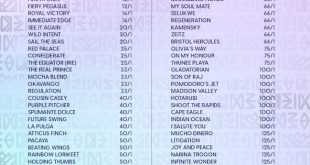The exotic bets have become easier to catch since the introduction of Assessment Plates in Gauteng as this usually leaves approximately one to three horses potentially well in at the weights.
Punters could also find an edge in other races if keeping up to date with the handicapping system in South Africa, which can leave horses potentially well weighted even in handicaps.
South African handicapping is based on the globally popular Merit Rating system but a number of rules have been added to restrict the handicappers’ power.
The restrictions are in place to prevent horses from becoming unfairly handicapped.
An offshoot is that some horses slip through the net and become well handicapped.

Listed below is a sample of five of the many rules which can potentially leave a horse as an eye-catcher at the weights.
1) The maximum penalty applicable to any handicap on either surface shall not be higher than 8 merit rated points. This is not applicable to Graded and Listed races, or horses carrying over-weight or weighted under sufferance. (A recent amendment said this also applies to Listed handicaps).
If a horse wins a 1600m handicap by five lengths it could be in for a potential raise of ten merit rated points considering one length equals two points over that trip. However, the handicapper will only be able to give it a maximum of eight points due to the above rule, so it should theoretically be 1kg well in when next running in a handicap. Of course if a six-year-old achieves such a feat it should be treated with caution as it might have been due to freak circumstances. However, if a progressive three-year-old achieves it, one should sit up and take notice.
2) For Grade 1 and Grade 2 races there is upward Adjustment to the first 5 finishers only and in Listed and Grade 3 races upward adjustment to placed horses only. Related to this is a recent amendment stating: The winner and placed horses in a Grade 2 or Grade 3 race is capped at a 10 point penalty for the winner, 5 points for 2nd place and 3 points for 3rd place.
A good example of a horse who has become potentially well handicapped due to the above restrictions is Senatla. This horse finished 2,25 lengths behind the merit rated 115 Twist Of Fate in the Grade 3 Politician Stakes over 1800m when receiving 7kg. On that run he was only 18 merit rated points inferior to Twist Of Fate, which put him on a 97 rating, although the horses who finished around him suggested he had run to his 84 merit rating. He was only allowed to be given a five point raise so went to an 89. Then in the Grade 1 Cape Derby over 2000m he finished seventh so escaped punishment. He finished two lengths behind Bunker Hunt, who went up to a 100 merit rating, so on paper Senatla should in comparison be about a 97 over that distance. Therefore, he will be potentially well handicapped off his 89 rating next time. This is particularly in light of the 2000m trip of the Derby having likely stretched him. His best trip, as one who races quite strongly, looks to be from 1400m to a mile. He is one to look out for in a forthcoming handicap.
The Sun Met sixth-placed Doublemint will also be well handicapped for the Vodacom Durban July. He escaped punishment and remained on a 104 merit rating despite having finished on top of five horses who are now all rated in the 120s.
The July horse who fell in to that boat last year was African Night Sky, having also finished sixth in the Met. He duly started favourite for the July and could well have gone close had there been a truer pace as he unfortunately began pulling the jockey’s arms off.
3) Currently, a 4 y.o. and older maiden winner must be capped at a nett MR of 70 in a major centre, 65 in PE, 60 in Kimberley and 58 in Zimbabwe. The discretion to vary this in exceptional circumstances no longer applies.
This restriction can leave late blooming horses well handicapped on occasion and they are then able to run up a sequence of handicap wins. A good example can be provided by Chepardo, who made his debut in the November of his four-year-old year. He was given the maximum rating of 70 for his comfortable win over 1160m and won his next three races, all handicaps from 1200-1700m, comfortably.
4) In minor plate races placed horses will not be adjusted upwards unless requested by the connections.
Horses can run close up in plate races when way under sufferance at the weights and they then look well handicapped when running next time out in a handicap. However, punters should be wary of this scenario as top horses often use races such as Pinnacle events as a preparation and the lower rated horses can be flattered, so it is worth watching the replays to see just how hard ridden the higher rated horses were.
5) Horses not having made the anticipated WFA improvements must be brought back to its highest achieved nett rating within 3 runs.
In this regard watch out for young horses who come down the ratings and are then stepped up to a potentially more suitable trip. This can be seen in the career of Wonderous Climber, who easily won a Maiden Juvenile Plate over 1600m in the May of his two-year-old season and was accorded a merit rating of 85. He then continually disappointed and his gross merit rating had to be continuously dropped to keep up with his highest achieved nett merit rating. He had eventually plummeted down to a 61 gross merit rating by the November of his four-year-old year. This corresponded almost identically with his highest achieved nett merit rating considering two-year-olds in May receive 23 half-kilograms over 1600m (85-23=62). However, he then found his forté when stepped up to staying trips and won four handicaps on the trot.
The handicapping guidelines and accompanying amendments and restrictions can be found on www.nhra.co.za. It can pay to learn their ins and outs.
By David Thiselton






